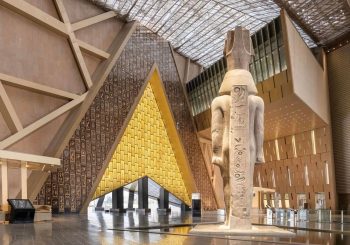By Saada Abd Elkader
With an exhausted, restless body, Omar tries to pick his head up from his pillow. He attempts to get out from under his warm blanket, which provides him with a getaway from the cold winter nights and from his day job inside the ice factory.
In front of the factory’s dormitory, he and his 16 fellow workers gather bits of wood and create the small fire from which they will keep themselves warm and make their tea for the rest of the work day.
Inside the ice factory, the temperature can reach four degrees Celsius on winter days, Omar says, although he adds that the factory workers have gotten used to the nature of this job.
With his plastic gloves, plastic shoes and other pieces of plastic covering his body, Ibrahim Abu Shama spends long hours carrying and moving the ice blocks from their metal carriers in an attempt to avoid their melting.
Abu Shama feels his “blood drying up in the veins from the cold,” he says, adding that the severity of the temperature is “paralyzing” and that even the plastic does not help much.
Abu Shama is one of 1200 workers in the ice-production factories, which number up to approximately 47, according to Ahmed Samy, the media spokesperson for the industrial development authorities.
Inside the factory
Inside the ice factory in Mattariya in the Daqahliya governorate, the temperature was half what it was outside. This factory produces 1500 ice blocks a day.
The doorway into the factory is long and narrow. To the right, one will find the wooden stairways that take one up to the cooling lounge. There, one will find floors covered in thick wood to ensure durability and the rectangular boxes, where the ice is made.
Each of the 50 boxes lying next to each other measures up to little less than a metre and is15 centimetres wide.
Using ammonia, the workers freeze the water inside the rectangular boxes and empty the boxes of the ice blocks once again using a winch.
Abu Shama says he would not think twice if he had an opportunity to leave the factory as he fears for the toll this jobs is taking on his health. He added that he only works at the ice factory now because this is the only profession he has learned and he has been unable to find any other job.
According to Samy, there are around 10,000 people whose work is indirectly related to the production of ice, whether through its sale or its distribution.
Ahmed Abdel Ghany, a truck owner, is one of those people. He buys the ice from the factory and uses his truck to move around and sell the ice blocks to fish and juice shops. Usually he buys and sells around 100 ice blocks.
His situation is not much better than that of his colleagues inside the factory. He says he puts up with the difficulties of this job and the physical labour it requires, especially in the winter, because it is his only source of income.
Abdel Ghany often makes a profit of EGP 150 (approximately USD 19); he buys blocks from the factory for EGP 4 per block and sells them for EGP 5.5 each.
According to Samy, a total of 100,000 ice blocks are produced per day in the winter and 200,000 are produced in the summer, when the demand is higher.
Mahmoud Saadawy, a professor of industrial medicine at Zagazig University, said that ice workers are vulnerable to Amyotrophic Lateral Sclerosis (ALS), a rapidly progressive and fatal neurological disease that hits at the nerve cells responsible for controlling voluntary muscles.
Many of the chemicals used in the cooling process, primarily the ammonia, pose such neurological health risks. There are no official statistics regarding how many ice factory workers suffer from these health conditions, Saadawy said.
The factory owners
Ahmed Awad, an ice factory owner in Cairo, said that ice production is a business that currently faces the threat of extinction. However, he maintains that ice producers would not switch to the production of any other product as this would incur huge losses for them. Furthermore, getting licensing from authorities is a long process and their licenses are only relevant to ice production.
Awad said that the ice factories use up to 750 cubic liters of water per day. Abdel Aal al-Shawa, a chairman of an ice factory, complained that water and electricity bills are getting higher and that they are not proportional to the prices of ice blocks.
Owners also believe that the increasing prices of water and electricity will lead to the closure of factories and the displacement of the labourers, because they cannot pay the bills.
Translated by Jihad Abaza. This content is from: Aswat Masriya







Comments (0)